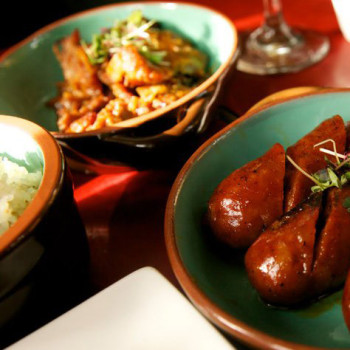Food-trend followers are always looking for the next ethnic cuisine to bubble up into a trendy dining delight. Step aside Peru and Scandinavia, because the new hip dishes are coming from the Philippines.
With almost a hundred million residents, the southeast Asian country is the twelfth most populous in the world – but even with a large diaspora community, it has yet to really break through on the Western food scene.
That’s starting to change with restauranteurs like Nicole Ponseca, who has opened two New York City establishments, Maharlika and Jeepney, specializing in modernized takes on her family’s food (and, yes, she finally told her parents that’s what she does).

Nicole Ponseca: We’re the fastest-growing minority, highest educated, highest income, and no one knows our food. Every hospital you go to, someone Filipino is taking care of you.
Brendan Francis Newnam: Could that be part of the story? Is it that Filipino immigrants didn’t focus on restaurants, and instead they went into healthcare and other professions?
Nicole Ponseca: Absolutely. We very much value education and status jobs for ego, to say my daughter is a nurse, or my daughter is a doctor – but also it’s risk-averse. We were not asked to become entrepreneurs. We were not asked to run a restaurant. In fact I held this as a secret from my parents until the press started coming out, cause I didn’t want them to be disappointed.
Brendan Francis Newnam: Really? So you were secretly opening this restaurant in New York?
Nicole Ponseca: Yeah, and only because they found the press, and they were like, “Nicole, what is this Facebook post about your restaurant? You’re not in advertising anymore?” It’s like, “Uh yeah, I have a Filipino restaurant, so…”
Brendan Francis Newnam: What was their reaction?
Nicole Ponseca: This was their reaction.
Brendan Francis Newnam: Stone-faced. Silence.
Nicole Ponseca: Their reaction was like, “What about health insurance? What about your savings?” You know, like they were concerned.
Brendan Francis Newnam: So, let’s talk about the food itself. What are some of the broad themes of Filipino food?
Nicole Ponseca: I say that
Filipino food is the soul food of Asia, and we’re almost the original fusion food. We were Malay – descendants of Malay – and then you name a country and we were probably conquered by them, or colonized.You take a little bit of Chinese and noodles and stir-fry, and the idea of fresh vegetables quickly cooked with simple garlic or aromatics like chives and stuff. And one-pot stews that we got from Spain. Like deep stews that you cannot mimic in an hour. And also out of practicality, because while we’re picking in the rice field, that cheap cut of meat is tenderizing so much, the fattiness and the meatiness is mixing with potatoes and tomatoes and vegetables. That is all Spain. Then from the Malay, we get the use of coconut milk and fermented shrimp paste.
So you have all these things, and it’s a soul food. It’s not precise. It’s not like Japanese, which is so beautiful and specific.
Brendan Francis Newnam: Can you just give me some of the hits? We’ll do half of a David Letterman skit. The top five Filipino dishes.
Lumpia
Nicole Ponseca: Okay. Coming in on number five is lumpia. Lumpia is a spring roll, and every Asian culture has some sort of spring roll, some sort of vegetable or meat filling that’s wrapped in a rice crepe and fried.
Pancit
Number four on the list would be pancit. Pancit just means noodles. It’s just like in Italy, for example, you have spaghetti carbonara or fettuccine alfredo.
Brendan Francis Newnam: And what kind of noodles are they?
Nicole Ponseca: All rice noodles in varying thickness or length.
Brendan Francis Newnam: What is the flavor profile? What differentiates it from spaghetti carbonara or pad thai? What would be some Filipino classic flavors?
Nicole Ponseca: Fermented shrimp paste or fermented fish sauce called patis or bagoong.
Brendan Francis Newnam: Sounds good. I interrupted your list here. We’re at number three.
Adobo
Nicole Ponseca: I’m probably gonna get some debate over this, but I would say for me, it is adobo. Adobo is our national dish in the Philippines, that’s what they call it anyway. It’s any dish that is made with a lot of vinegar, soy sauce, bay leaf, peppercorns and garlic.
Brendan Francis Newnam: So this is the kind of vinegary stew that I’ve heard about when I think of Filipino cuisine?
Nicole Ponseca: Yeah. And why it’s so special to the Philippines is because it’s been said that we are the ones that invented stewing food with vinegar to protect it during typhoon season. It can literally sit and sit and it just gets better and better, and so sour and it’s so salty, and you have to eat so much rice with it. It’s so good.
Brendan Francis Newnam: But it’s only number three.
Nicole Ponseca: It’s only number three because there are two other dishes that just really sing to me as being a Filipino.
Arroz Caldo
Number two on my dish would be arroz caldo. Arroz caldo is a rice porridge and you can see some of our Chinese influence. It’s intense ginger and garlic and chicken broth. We make a little saffron oil to put on top.
Brendan Francis Newnam: Okay, so then what’s number one?
Kare-kare
Nicole Ponseca: Number one for me, and this is only me so I can’t speak for everyone, is kare-kare. Kare-kare is our oxtails. It’s slow cooked. My dad would cook it on special occasions for me. He would cook it for hours. It’s with the peanut butter sauce and the fermented shrimp paste.
And I really want to say there is so much more. Like, there’s tinola, but for me, the reason why kare-kare was so poignant is because
I remember distinctively when I was four and my mom said, “Don’t feed her the fish paste. She won’t like it. Maybe she’s already too Americanized. Maybe she won’t honor being Filipino.” And my dad was like, “No. This girl is Filipino. She’ll love it.” And I ate it up, and I’ve loved it ever since.
Brendan Francis Newnam: Aww! Wait, is that a story that you test marketed at Saatchi & Saatchi?
Nicole Ponseca: Stop it, no, that’s the truth.


